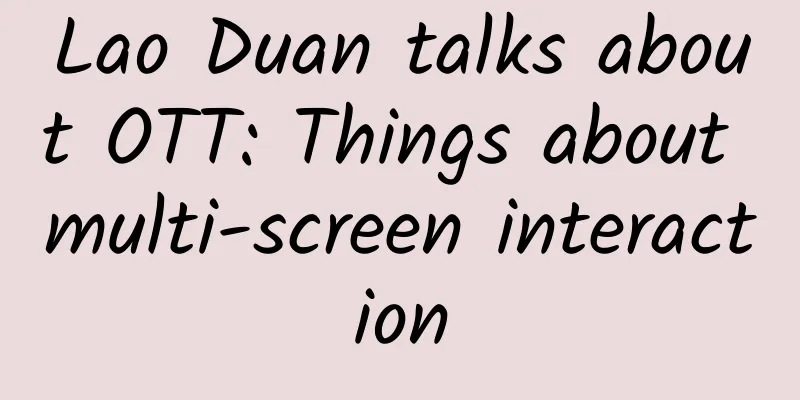Lao Duan talks about OTT: Things about multi-screen interaction

|
Duan Youqiao, an artist of iQiyi. From an Internet company to DTV, IPTV, STB and OTT, after 12 years, he has returned to an Internet company after a long journey. The journey is not short but the distance is zero. Multi-screen interaction is a hot topic. Duan is here to join in the fun. Welcome to discuss! I have always said that DLNA and Airplay for multi-screen interaction only point out the future of television, but do not bring any financial prospects to television. Instead, they almost ruined television. First, this protocol is very unstable and often requires "trying your luck" to use. The reasons for this are problems with the protocol itself, as well as problems with home LANs, routers, and the TCPIP mechanism itself. Second, throwing online videos on the mobile phone onto the TV is like taking a close look at a beautiful woman. The large and high-definition screen makes the video that originally looked clear enough on the small screen unwatchable, thus making users habitually think that TV is not as enjoyable as PHONE and PAD. Third, if you watch online videos on TV, you will have to go back to your phone and start over if you want to change episodes of a TV series, check out related video recommendations, switch the clarity, or make some settings such as skipping the opening and ending credits. Humans can be lazy when they can, and this kind of operation where hands and eyes frequently switch back and forth between TV and mobile phones is too complicated. Therefore, I have always advocated that "there is no user experience without cloud-based multi-screen interaction". Only multi-screen interaction with cloud-based participation can completely transform multi-screen interaction from a selling point customer experience to a user experience. Of course, this view does not include applications such as MIRACAST between two local devices. Therefore, Yuan Ming, who recently came out of a certain video website with a halo of 10 billion investment and a 100 market value pocket, and sold "touch and try" multi-screen interaction on the streets and after dinner, came to another video website to talk to me about multi-screen interaction! In my eyes, Mr. Yuan is not like the chairman of a company with a market value of 10 billion, but more like a product manager who is penny-pinching, with dreams in his heart, a bit of JOBS-like idealism and persistence or stubbornness, I like it very much. After the argument, we both asserted that the other party was out of his mind! Haha, who got in and who didn't, we will see in three months. In the next round, I went to Shenzhen, and Tongzhou continued to meet iQiyi. By the way, I have a view that "in the future, TV and mobile phones will be accessories to each other". TV is the big screen of mobile phones, and mobile phones are the remote control of TV. It seems that I learned better than my classmate Lei Jun in middle school politics. He only said "TV is an accessory of mobile phones", which is obviously not as dialectical as me! Haha, in addition to the simplest multi-screen interaction using only standard DLNA and UPNP protocols mentioned above, there are three product directions or models dedicated to improving the multi-screen interaction experience of mobile phones and TVs: (1) Mobile phone mode: This mode is that everything is done by the mobile phone, and the large screen of the TV is only used when playing. That is to say, before playing, your hands and eyes are busy on the mobile phone screen. There is almost no UI and interface for control on the TV side. A typical example is Apple's Airplay, which has the screen projection button only on the playback interface. In addition, almost all dongle products adopt this mode without exception, and the recent CHROMECAST and Baidu video stick are the newcomers among them. The advantage of this model is that the technology development and product design are simple. The connection between the mobile phone and the TV is limited to the transmission of some protocol parameters. Compared with the basic DLNA, it can transmit commands beyond fast forward, fast rewind, pause, volume control, etc. Disadvantages: The TV still plays videos with the same clarity as the mobile phone, which is very tragic and continues the business of discrediting the clarity of large-screen TVs, haha! In addition, other controls are all on the mobile phone, the screen is small, not very convenient, and not suitable for long-term living room or bedroom scenes. Moreover, it is impossible to do operations such as changing episodes, changing clarity, recommending, interacting, etc. directly on the TV. This model is suitable for companies that only have mobile clients but no TV clients and hardware, that is, companies that extend more from the mobile phone to the TV side. (2) TV mode: That is, all interfaces of the mobile client can push any icon, text and video to the TV or pull it back (instead of playing on the phone and then pushing the film to the TV. If you want to watch a video on the TV in the living room, you must first play it on the phone. I think there is a saying that is very suitable: take off your pants XXXX, haha, swear words!), and the video played on the TV is clearer. In addition, only one unified mobile client is used. After pushing the film, the mobile phone screen immediately turns into a "blind control" remote control. Not only can the video client be controlled remotely, but also the homepage, games, and applications can be controlled remotely. You can say goodbye to the remote control. The important difference from the mobile phone mode is that there is a UI interface on the TV side. People look at the TV screen with their eyes and hold the mobile phone in their hands to operate the TV like a remote control. Compared with the standard DLNA, this product and technology is more complex, involving the coordination between the two ends, and is suitable for companies that have both mobile and TV software. Of course, the user experience will be much better. iQiyi and Xiaomi adopt this model. Because iQiyi does not have its own brand hardware, it directly implements this function on the mobile video client. Because Xiaomi does not have a mobile video client but has hardware, it focuses on its own hardware to do a good job of local film promotion and remote control, and the user experience is also very good. There are also many products, including LeTV and almost all kinds of TV manufacturers, which have an independent mobile phone remote control TV client, which is separate from the mobile video client. I think the experience of this model is poor, and the download volume and frequency of use have proved this point. And this function of iQiyi is used very frequently on TCL iQiyi TV and Skyworth iQiyi ultra-clear box, which is currently only in internal testing. Playing high-definition on TV and being able to blindly control all interfaces is a very good user experience in some scenarios. These product managers have obviously overestimated users' patience by asking users to download and use another mobile client just to control the TV (instead of the remote control). If it was just a selling point, it has achieved its purpose. (3) Screen transmission mode: It is to synchronize the interface of the TV screen in real time, transfer the screen to the mobile phone, and then operate the TV by touch on the mobile phone. This requires the mobile phone to "know" the coordinates of each clickable focus on the TV when touching. With the enhancement of the CPU and RAM of mobile phones and set-top boxes, the 128M memory shortage when Jobs released the iPhone is gone forever. The key to this mode is that all operations are on the mobile phone. People can look at the TV when browsing roughly, such as sliding the screen to turn the page, but for fine control, both hands and eyes must return to the mobile phone. In theory, this is the intermediate state between the first mode and the second mode mentioned above. Tongzhou's Touch and See is a typical product of the screen transmission mode. Huawei's solution department also has similar products, but they are not promoted much. The difficulty of this mode lies in how to make the focused TV interface suitable for touch operation, or vice versa. I am not kidding when I say that Yuan Ming is an idealist. This control must be coordinated with the mobile phone and the TV. Both sides must be suitable for each other. Whether the focused control and the sliding screen touch can be unified in the user experience is still an academic issue. Moreover, in leisurely scenes such as bedrooms and living rooms, whether this hand-eye conversion will be accepted by users still has some way to go. However, unlike the first model, Mr. Yuan still equipped each set-top box with a remote control, haha! I really like the discussion and debate with Yuan Ming. Fortunately, Yuan Ming is not as foul-mouthed and arrogant as Steve Jobs. In addition to the different backgrounds and resources of iQiyi, which has a large number of mobile video clients and TV video clients, and Tongzhou, which has hardware set-top boxes, our debate can more or less reveal some clues about the future of multi-screen interaction between mobile phones and TVs, either consensus or disagreement. It is also good to throw out some ideas or at least to stimulate discussion and debate: (1) Should the TV have an operable UI interface? Where should the user look when operating? I think that the remote control on the mobile phone should cater to the control experience of the remote control, and use the push-pull tab as a new function added to the TV for local time and local occasions, rather than all. There are two scenarios for watching TV. The first is that you are watching or looking for videos with your mobile phone. After returning home or moving to the bedroom, you push the video to the TV. Then, because the mobile phone is in your hand instead of the remote control, you can use the mobile phone to control all the functions of the video and all other TV functions other than the video. And because the TV has a UI interface, this control should maintain the highest degree of consistency with the original remote control operation of the TV in terms of key position, habits, interface, function, and process. The second scenario is watching TV on the sofa and in bed. If there is no need for push-pull tabs and multi-screen interaction, it is better to use a remote control. This little thing that sells for 7.5 yuan on Taobao, has 39 keys, and has been prosperous for 57 years, is still not replaceable by a 2,000 yuan Android phone or even a 4,000 yuan Apple phone in terms of its essence or its core advantages. The remote control still has better accessibility and is simple and easy to operate. Mobile phones can receive calls, text messages, WeChat messages, standby, lock, and a series of other functions. As a customer experience (selling point), it is great, but the user experience (long-term continuous use) is not good. The reason is very simple. This is an auxiliary function of a multi-functional mobile phone. A mobile phone is a device that a person carries with him 24 hours a day and things can happen at any time. It is not possible to put "whole body and mind" on the remote control of the TV at a certain time and occasion. For example, when watching TV, what state should the mobile phone be in? It is not difficult to come to a conclusion if you think about it. The core competitiveness of remote controls is only two: simplicity and cheapness, which are not comparable to mobile phones. (2) More is not as good as less. In most cases, revolution is not as good as innovation. In the past 2000 years, there were countless people shouting about revolution and subversion, but there were only a few dozen or even a dozen who really did. Just like in the end, it was the seemingly low-tech telephone lines and WIFI rather than those so-called revolutionary new technologies that promoted the Internet and mobile Internet, the availability, ease of use and laziness of products are important product concepts that we often overlook. When you usually use a remote control to operate the TV, your phone happens to have an iQiyi mobile client, which can easily push high-definition content to the TV. At this time, you can just use your phone to control the TV. Of course, you can also use the remote control, and they can operate all the functions of the TV at this time, instead of just some functions like DLNA and Airplay. This is the operating experience that conforms to human nature. Multi-screen interaction is like Internet TV, which is not a subversive thing. Without revolutionary technology and business models, it is impossible not to be a complete revolution from carriages to cars. Therefore, mobile phone control can replace remote controls in some scenarios. It is more convenient and easier to use, but it will not completely replace remote controls, let alone be better than remote controls in all scenarios. Most multi-functional things cannot achieve the best user experience, and the reason goes without saying. To give an inappropriate example, Western food is good and we like it. It is very pleasant to eat in some situations, but we will not completely change the habit of eating Chinese food. In a broader sense, this is actually similar to the intersection of scientific spirit and humanistic feelings advocated by Steve Jobs. As a winner of Toutiao's Qingyun Plan and Baijiahao's Bai+ Plan, the 2019 Baidu Digital Author of the Year, the Baijiahao's Most Popular Author in the Technology Field, the 2019 Sogou Technology and Culture Author, and the 2021 Baijiahao Quarterly Influential Creator, he has won many awards, including the 2013 Sohu Best Industry Media Person, the 2015 China New Media Entrepreneurship Competition Beijing Third Place, the 2015 Guangmang Experience Award, the 2015 China New Media Entrepreneurship Competition Finals Third Place, and the 2018 Baidu Dynamic Annual Powerful Celebrity. |
<<: Automobiles and home appliances are the backbone of China's industry
>>: Lao Duan talks about OTT: 8 common misunderstandings about Internet TV
Recommend
Tesla delays electric truck launch due to lack of production capacity
The production capacity problem of Tesla's ne...
Hunter e-commerce: Hang up the data, only one mobile phone can make a monthly profit of 100,000+ (internal play method) worth 4988 yuan
Hunter e-commerce: Hang up the machine to run the...
Why are there so many different flight configurations for helicopters? What are their characteristics?
Compared with fixed-wing aircraft, helicopters ca...
iPhone 4 and first-generation iPad will not be eligible for iOS 8
There are many things that Apple is really good at...
Mobile game startup review: Why did the company fail 3 and a half years after its establishment?
As competition in the mobile game industry become...
Electric Technology Car News: How can the Lifan X80, which is very similar to the Highlander in appearance and interior, make a comeback?
This year, the automobile market has welcomed man...
If AI is used "wrongly", people will really become stupid! I'm not kidding you
One day in AI is like one year in the human world...
Scrcpy open source Android device control tool
Scrcpy is a powerful open source Android device c...
Front-end - the most artistic programmer
[[154705]] The rise of front-end engineers A long...
What is Touch Bar? 13-inch Touch Bar version of MBP disassembled
On November 17, the famous foreign disassembly te...
I'm curious about whether girls use their hands or something else to solve physiological problems.
Whose cat doesn’t go into heat, and whose girl do...
How come tumbleweeds, which are the public’s nightmare and have put the United States into a state of emergency, are considered a delicacy by us?
In 2014, two cities in Colorado declared states o...
Tik Tok, are they really the next operational frontier?
Since April, I have repeatedly heard that the ope...
Android phone RAM can no longer be rolled up, good quality and low price are the best
As the 2022 Android flagships debut one after ano...
Mom and Dad, don’t be stingy with money, just eat these 4 snacks!
Nowadays, young people are very happy to buy snac...









